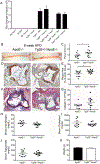Caspase-1 Activation Is Related With HIV-Associated Atherosclerosis in an HIV Transgenic Mouse Model and HIV Patient Cohort
- PMID: 31315440
- PMCID: PMC6703939
- DOI: 10.1161/ATVBAHA.119.312603
Caspase-1 Activation Is Related With HIV-Associated Atherosclerosis in an HIV Transgenic Mouse Model and HIV Patient Cohort
Abstract
Objective: Atherosclerotic cardiovascular disease (ASCVD) is an increasing cause of morbidity and mortality in people with HIV since the introduction of combination antiretroviral therapy. Despite recent advances in our understanding of HIV ASCVD, controversy still exists on whether this increased risk of ASCVD is due to chronic HIV infection or other risk factors. Mounting biomarker studies indicate a role of monocyte/macrophage activation in HIV ASCVD; however, little is known about the mechanisms through which HIV infection mediates monocyte/macrophage activation in such a way as to engender accelerated atherogenesis. Here, we experimentally investigated whether HIV expression is sufficient to accelerate atherosclerosis and evaluated the role of caspase-1 activation in monocytes/macrophages in HIV ASCVD. Approach and Results: We crossed a well-characterized HIV mouse model, Tg26 mice, which transgenically expresses HIV-1, with ApoE-/- mice to promote atherogenic conditions (Tg26+/-/ApoE-/-). Tg26+/-/ApoE-/- have accelerated atherosclerosis with increased caspase-1 pathway activation in inflammatory monocytes and atherosclerotic vasculature compared with ApoE-/-. Using a well-characterized cohort of people with HIV and tissue-banked aortic plaques, we documented that serum IL (interleukin)-18 was higher in people with HIV compared with non-HIV-infected controls, and in patients with plaques, IL-18 levels correlated with monocyte/macrophage activation markers and noncalcified inflammatory plaques. In autopsy-derived aortic plaques, caspase-1+ cells and CD (clusters of differentiation) 163+ macrophages correlated.
Conclusions: These data demonstrate that expression of HIV is sufficient to accelerate atherogenesis. Further, it highlights the importance of caspase-1 and monocyte/macrophage activation in HIV atherogenesis and the potential of Tg26+/-/ApoE-/- as a tool for mechanistic studies of HIV ASCVD.
Keywords: HIV infections; atherosclerosis; humans; macrophages; mice; monocytes.
Conflict of interest statement
Figures







References
-
- Lo J, Abbara S, Shturman L, Soni A, Wei J, Rocha-Filho JA, Nasir K and Grinspoon SK. Increased prevalence of subclinical coronary atherosclerosis detected by coronary computed tomography angiography in HIV-infected men. AIDS (London, England). 2010;24:243–253. doi: 10.1097/QAD.0b013e328333ea9e. - DOI - PMC - PubMed
-
- Burdo TH, Lentz MR, Autissier P, Krishnan A, Halpern E, Letendre S, Rosenberg ES, Ellis RJ and Williams KC. Soluble CD163 made by monocyte/macrophages is a novel marker of HIV activity in early and chronic infection prior to and after anti-retroviral therapy. The Journal of infectious diseases. 2011;204:154–163. doi: 10.1093/infdis/jir214. - DOI - PMC - PubMed
Publication types
MeSH terms
Substances
Grants and funding
LinkOut - more resources
Full Text Sources
Medical
Molecular Biology Databases
Miscellaneous

